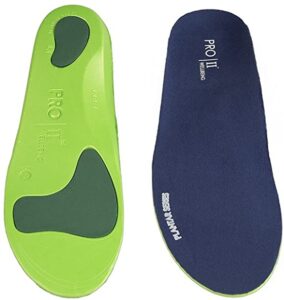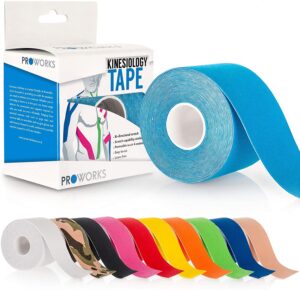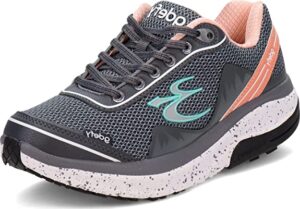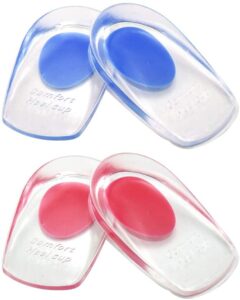Plantar fasciitis is inflammation of the band of tissue that spans the bottom of your foot (from heel to toes).
Symptoms:
-
Increased pain first thing in the morning.
-
Tenderness when you press or put pressure over the inside edge of the heel.
-
Worse pain felt on stairs / harder surfaces.
-
The pain often feels better during exercise, but returns after resting.
-
It might be difficult to raise your toes off the floor.
-
Pain may be in the arch of the foot or centrally in the foot (usually coming from the heel initially).
Causes:
-
Changes in hormones increasing elasticity in ligaments and tendons of the foot.
-
Increased weight (carrying a growing baby before / after pregnancy).
-
Tight / weak in the calf muscles and tendons leading to the foot (associated with plantarfasciitis).
-
Recent change in activity.
-
Wearing shoes with poor cushioning or shoes that are badly fitting.
Here is what the evidence says about the treatment options:
Exercise – The theory is that if you increase the strength throughout the rest of the body, in particular the lower back, abs, glutes, thighs and calves, then you take the added strain off the feet and reduces the stress through the plantar fascia (the tough band of tissue on the bottom of the feet). There is some good evidence for the use of exercise in treating plantar fasciitis, have a look at THIS study.
Have a look at our Top 5 online Pilates programmes here.
Yoga – Another way to increase your strength and stability is through Yoga. Yoga is a safe and effective exercise that can be done throughout your pregnancy and soon after the birth also.
There are lots of Online Yoga programmes available, have a look at our Top 5 here (and why we love them)! You can also read our blog on how yoga can help in other ways.

Taping – evidence suggests that taping is an effective short-term treatment for people suffering with plantar-fasciitis. I use it a lot with my patients and I can confirm that it does provide some instant relief. I think it needs combining with some other modalities however, to get more long term results. HERE is a great example of how you would use kineso-tape for plantar fasciitis. THIS is the tape that we would recommend based on reviews / popularity.
Insoles – THIS study found that full length insoles were more effective at treating plantar fasciitis than heel cups. THIS study reported that Plantar-fasciitis can be significantly improved with stretching, heel raises, and orthoses (insoles) that provide arch support. THIS study however, found that when combined with stretching and strengthening exercises, heel cups could help to resolve most plantar fasciitis cases and are at least as effective as nonsteroidal anti-inflammatory drugs or steroid injections. These are the type of insoles that we would usually recommend for plantar fasciitis. They have thousands of really good reviews and are a very reasonable price.
Rocker shoes – evidence suggests that the use of rocker shoes can be helpful. THIS study found that combining Rocker Shoes with insoles enhances improvement in pain relief and function in patients with plantar fasciitis. Here is another study in support of rocker shoes also and is worth a read as it is quite detailed. THESE are a good example of Rocker Shoes that are available, with any trainers though, it is down to personal preference, foot width, arch and type of activity you use them for. Always try them around the house before using them outdoors in case you need to send them back.
Self massage – evidence is limited when it comes to massage alone for plantar fasciitis. I find that it can help in the short term for some instant relief but it needs combining with other modalities for a more long-term benefit. Self massage can be done with a massage ball (or tennis ball).
Shockwave – This is a therapy that is often offered if nothing else is helping. Shockwaves are acoustic pressure pulses of microsecond duration. It is theorised that these acoustic waves interact with tissue, causing overall medical effects of accelerated tissue repair and cell growth, pain relief and mobility restoration. Lots of studies support the use of Shockwave. If you would like to discuss this as a treatment then speak to your GP or call your local Physiotherapy clinic and ask if it is a service they provide (not all Physiotherapists are qualified to administer Shockwave).
Really helpful links we think you’ll love:
Have a look at THIS video by Finolaphysio for a good examples of plantar fasciitis exercises and self massage techniques.
Side note – Fat Pad Syndrome:
This is a condition that is much less common but worth noting. The condition involves the loss of fat pads in the balls of the feet, which causes thinning of the protective cushioning that sits under the bones. This condition requires more TLC-type treatment than plantar fasciitis so treatment options are limited.
Symptoms might include:
-
Pain like a bruise with prolonged walking / standing.
-
The feeling of having a small rock in the shoe.
-
Pain when walking bare footed or with non-cushioned shoes.
-
Pain is often worse at night and can be painful even when your feet are resting.
-
Pain will be central in the heel.
Treatment options:
Taping – evidence for taping when it comes to heel pain is mixed. It is thought that results are good but short term. I find it effective when combined with other treatments like self-massage and strength work. THIS is a great video showing how to tape for heel pain. The tape we recommend based on reviews is THIS one.
Insoles – evidence is of moderate-quality when it comes to the use of insoles for reducing pain in the heel. THIS study suggests that they are effective in the medium term so might be a good option if this is a new issue and just associated with your current pregnancy. I would usually recommend a heel cup with very good cushioning when it comes to heel pain. THESE are a good option once you are sure of this as your diagnosis.
We also recommend –
-
Consider taking a break from intense athletic training and avoid high impact training.
-
Stretch and strengthen regularly (try these by our friends over at Finolaphysio).
-
Ensuring proper footwear that is densely cushioned and provides enough support to the bottom of the feet at all times.
-
Try to avoid wearing high heels, especially pointy heels, as high heels can poorly distribute the weight of the body, putting excessive pressure on one area of the foot.
-
Avoid walking barefoot, particularly on hard or uneven surfaces.
-
Try to maintain a healthy BMI.




